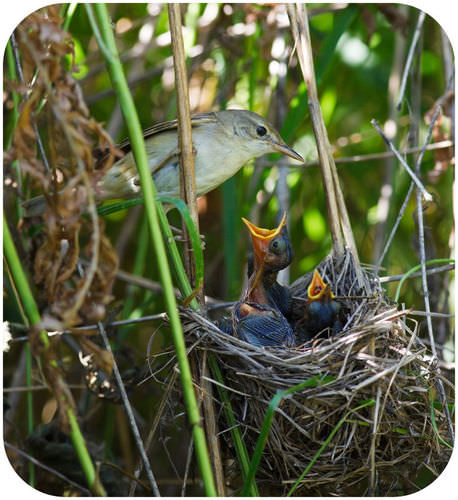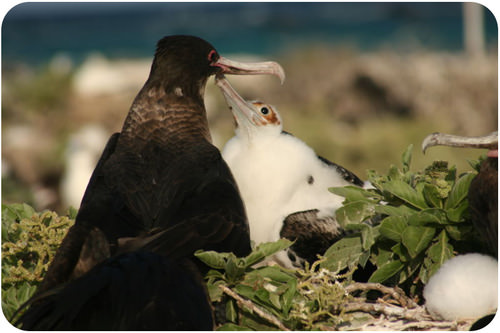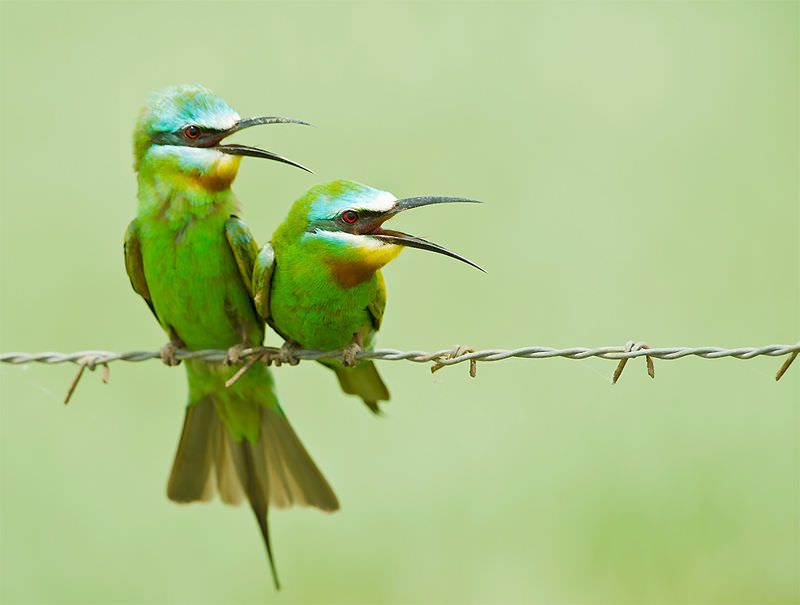12.12: Bird Reproduction
- Page ID
- 13248
\( \newcommand{\vecs}[1]{\overset { \scriptstyle \rightharpoonup} {\mathbf{#1}} } \)
\( \newcommand{\vecd}[1]{\overset{-\!-\!\rightharpoonup}{\vphantom{a}\smash {#1}}} \)
\( \newcommand{\dsum}{\displaystyle\sum\limits} \)
\( \newcommand{\dint}{\displaystyle\int\limits} \)
\( \newcommand{\dlim}{\displaystyle\lim\limits} \)
\( \newcommand{\id}{\mathrm{id}}\) \( \newcommand{\Span}{\mathrm{span}}\)
( \newcommand{\kernel}{\mathrm{null}\,}\) \( \newcommand{\range}{\mathrm{range}\,}\)
\( \newcommand{\RealPart}{\mathrm{Re}}\) \( \newcommand{\ImaginaryPart}{\mathrm{Im}}\)
\( \newcommand{\Argument}{\mathrm{Arg}}\) \( \newcommand{\norm}[1]{\| #1 \|}\)
\( \newcommand{\inner}[2]{\langle #1, #2 \rangle}\)
\( \newcommand{\Span}{\mathrm{span}}\)
\( \newcommand{\id}{\mathrm{id}}\)
\( \newcommand{\Span}{\mathrm{span}}\)
\( \newcommand{\kernel}{\mathrm{null}\,}\)
\( \newcommand{\range}{\mathrm{range}\,}\)
\( \newcommand{\RealPart}{\mathrm{Re}}\)
\( \newcommand{\ImaginaryPart}{\mathrm{Im}}\)
\( \newcommand{\Argument}{\mathrm{Arg}}\)
\( \newcommand{\norm}[1]{\| #1 \|}\)
\( \newcommand{\inner}[2]{\langle #1, #2 \rangle}\)
\( \newcommand{\Span}{\mathrm{span}}\) \( \newcommand{\AA}{\unicode[.8,0]{x212B}}\)
\( \newcommand{\vectorA}[1]{\vec{#1}} % arrow\)
\( \newcommand{\vectorAt}[1]{\vec{\text{#1}}} % arrow\)
\( \newcommand{\vectorB}[1]{\overset { \scriptstyle \rightharpoonup} {\mathbf{#1}} } \)
\( \newcommand{\vectorC}[1]{\textbf{#1}} \)
\( \newcommand{\vectorD}[1]{\overrightarrow{#1}} \)
\( \newcommand{\vectorDt}[1]{\overrightarrow{\text{#1}}} \)
\( \newcommand{\vectE}[1]{\overset{-\!-\!\rightharpoonup}{\vphantom{a}\smash{\mathbf {#1}}}} \)
\( \newcommand{\vecs}[1]{\overset { \scriptstyle \rightharpoonup} {\mathbf{#1}} } \)
\( \newcommand{\vecd}[1]{\overset{-\!-\!\rightharpoonup}{\vphantom{a}\smash {#1}}} \)
\(\newcommand{\avec}{\mathbf a}\) \(\newcommand{\bvec}{\mathbf b}\) \(\newcommand{\cvec}{\mathbf c}\) \(\newcommand{\dvec}{\mathbf d}\) \(\newcommand{\dtil}{\widetilde{\mathbf d}}\) \(\newcommand{\evec}{\mathbf e}\) \(\newcommand{\fvec}{\mathbf f}\) \(\newcommand{\nvec}{\mathbf n}\) \(\newcommand{\pvec}{\mathbf p}\) \(\newcommand{\qvec}{\mathbf q}\) \(\newcommand{\svec}{\mathbf s}\) \(\newcommand{\tvec}{\mathbf t}\) \(\newcommand{\uvec}{\mathbf u}\) \(\newcommand{\vvec}{\mathbf v}\) \(\newcommand{\wvec}{\mathbf w}\) \(\newcommand{\xvec}{\mathbf x}\) \(\newcommand{\yvec}{\mathbf y}\) \(\newcommand{\zvec}{\mathbf z}\) \(\newcommand{\rvec}{\mathbf r}\) \(\newcommand{\mvec}{\mathbf m}\) \(\newcommand{\zerovec}{\mathbf 0}\) \(\newcommand{\onevec}{\mathbf 1}\) \(\newcommand{\real}{\mathbb R}\) \(\newcommand{\twovec}[2]{\left[\begin{array}{r}#1 \\ #2 \end{array}\right]}\) \(\newcommand{\ctwovec}[2]{\left[\begin{array}{c}#1 \\ #2 \end{array}\right]}\) \(\newcommand{\threevec}[3]{\left[\begin{array}{r}#1 \\ #2 \\ #3 \end{array}\right]}\) \(\newcommand{\cthreevec}[3]{\left[\begin{array}{c}#1 \\ #2 \\ #3 \end{array}\right]}\) \(\newcommand{\fourvec}[4]{\left[\begin{array}{r}#1 \\ #2 \\ #3 \\ #4 \end{array}\right]}\) \(\newcommand{\cfourvec}[4]{\left[\begin{array}{c}#1 \\ #2 \\ #3 \\ #4 \end{array}\right]}\) \(\newcommand{\fivevec}[5]{\left[\begin{array}{r}#1 \\ #2 \\ #3 \\ #4 \\ #5 \\ \end{array}\right]}\) \(\newcommand{\cfivevec}[5]{\left[\begin{array}{c}#1 \\ #2 \\ #3 \\ #4 \\ #5 \\ \end{array}\right]}\) \(\newcommand{\mattwo}[4]{\left[\begin{array}{rr}#1 \amp #2 \\ #3 \amp #4 \\ \end{array}\right]}\) \(\newcommand{\laspan}[1]{\text{Span}\{#1\}}\) \(\newcommand{\bcal}{\cal B}\) \(\newcommand{\ccal}{\cal C}\) \(\newcommand{\scal}{\cal S}\) \(\newcommand{\wcal}{\cal W}\) \(\newcommand{\ecal}{\cal E}\) \(\newcommand{\coords}[2]{\left\{#1\right\}_{#2}}\) \(\newcommand{\gray}[1]{\color{gray}{#1}}\) \(\newcommand{\lgray}[1]{\color{lightgray}{#1}}\) \(\newcommand{\rank}{\operatorname{rank}}\) \(\newcommand{\row}{\text{Row}}\) \(\newcommand{\col}{\text{Col}}\) \(\renewcommand{\row}{\text{Row}}\) \(\newcommand{\nul}{\text{Nul}}\) \(\newcommand{\var}{\text{Var}}\) \(\newcommand{\corr}{\text{corr}}\) \(\newcommand{\len}[1]{\left|#1\right|}\) \(\newcommand{\bbar}{\overline{\bvec}}\) \(\newcommand{\bhat}{\widehat{\bvec}}\) \(\newcommand{\bperp}{\bvec^\perp}\) \(\newcommand{\xhat}{\widehat{\xvec}}\) \(\newcommand{\vhat}{\widehat{\vvec}}\) \(\newcommand{\uhat}{\widehat{\uvec}}\) \(\newcommand{\what}{\widehat{\wvec}}\) \(\newcommand{\Sighat}{\widehat{\Sigma}}\) \(\newcommand{\lt}{<}\) \(\newcommand{\gt}{>}\) \(\newcommand{\amp}{&}\) \(\definecolor{fillinmathshade}{gray}{0.9}\)
Is this pair of birds actually a “couple”?
Yes. Birds do actually pair up each mating season, if not for life. And the male better be prepared to treat his female properly. There is actually an elaborate process in which the female chooses her mate.
Bird Reproduction
Reproduction in birds may be quite complicated and lengthy. Birds reproduce sexually and have separate sexes and internal fertilization, so males and females must mate for fertilization to occur. Mating is generally preceded by courtship. In most species, parents also take care of their eggs and hatchlings.
Courtship and Mating
Courtship is behavior that is intended to attract a mate. It may involve singing specific courtship songs or putting on some type of visual display. For example, a bird may spread out and display its tail feathers or do a ritualized mating “dance.” Typically, males perform the courtship behavior, and females choose a mate from among competing males.
During mating, a male bird presses his cloaca against his mate’s cloaca and passes sperm from his cloaca to hers. After fertilization, eggs pass out of the female’s body, exiting through the opening in the cloaca.
Nesting and Incubation
Eggs are usually laid in a nest. The nest may be little more than a small depression in the ground, or it may be very elaborate, like the weaver bird nest in Figure below. Eggs that are laid on the ground may be camouflaged to look like their surroundings (also shown in Figure below). Otherwise, eggs are usually white or pastel colors such as pale blue or pink.
 Variation in Bird Nests. A weaver bird uses grasses to weave an elaborate nest (left). The eggs of a ground-nesting gull are camouflaged to blend in with the nesting materials (right).
Variation in Bird Nests. A weaver bird uses grasses to weave an elaborate nest (left). The eggs of a ground-nesting gull are camouflaged to blend in with the nesting materials (right).After birds lay their eggs, they generally keep the eggs warm with their body heat while the embryos inside continue to develop. This is called incubation, or brooding. In most species, parents stay together for at least the length of the breeding season. In some species, they stay together for life. By staying together, the males as well as females can incubate the eggs and later care for the hatchlings. Birds are the only nonhuman vertebrates with this level of male parental involvement.
Hatchlings
 Nest of a marsh warbler (Acrocephalus palustris) with baby birds
Nest of a marsh warbler (Acrocephalus palustris) with baby birdsGround-nesting birds, such as ducks and chickens, have hatchlings that are able to run around and feed themselves almost as soon as they break through the eggshell. Being on the ground makes them vulnerable to predators, so they need to be relatively mature when they hatch in order to escape. In contrast, birds that nest off the ground—in trees, bushes, or buildings—have hatchlings that are naked and helpless. The parents must protect and feed the immature offspring for weeks or even months. However, this gives the offspring more time to learn from the parents before they leave the nest and go out on their own.
Parental Care
In birds, 90% to 95% of species are monogamous, meaning the male and female remain together for breeding for a few years or until one mate dies. Birds of all types, from parrots to eagles and falcons, are monogamous. Usually, the parents take turns incubating the eggs. Birds usually incubate their eggs after the last one has been laid. In polygamous species, where there is more than one mate, one parent does all of the incubating. The wild turkey is an example of a polygamous bird.
The length and type of parental care varies widely amongst different species of birds. At one extreme, in a group of birds called the megapodes (which are chicken-like birds), parental care ends at hatching. In this case, the newly-hatched chick digs itself out of the nest mound without parental help and can take care of itself right away. These birds are called precocial. Other precocial birds include the domestic chicken and many species of ducks and geese. At the other extreme, many seabirds care for their young for extended periods of time. For example, the chicks of the Great Frigatebird receive intensive parental care for six months, or until they are ready to fly, and then take an additional 14 months of being fed by the parents (Figure below). These birds are the opposite of precocial birds and are called altricial.
In most animals, male parental care is rare. But it is very common in birds. Often both parents share tasks such as defense of territory and nest site, incubation, and the feeding of chicks. Since birds often take great care of their young, some birds have evolved a behavior called brood parasitism. This happens when a bird leaves her eggs in another bird’s nest. The host bird often accepts and raises the parasite bird's eggs.
 Great Frigatebird adults are known to care for their young for up to 20 months after hatching, the longest in a bird species. Here, a young bird is begging for food.
Great Frigatebird adults are known to care for their young for up to 20 months after hatching, the longest in a bird species. Here, a young bird is begging for food.Summary
- Birds reproduce sexually and have internal fertilization.
- Mating is generally preceded by courtship.
- Birds' amniotic eggs have hard shells and are laid in a nest. The eggs are usually incubated until they hatch.
- Most species have a relatively long period of parental care.
Review
- What is courtship? Give an example.
- Contrast hatchling maturity in birds that are ground-nesting and those that nest off the ground.
| Image | Reference | Attributions |
 |
[Figure 1] | Credit: Duncan Wright Source: commons.wikimedia.org/wiki/File:Great_Frigatebird_chick_begging.JPG License: CC BY-NC |
 |
[Figure 2] | Credit: Weaver nest: JM Garg; Gull eggs: Matt Poole/US Fish and Wildlife Service;Weaver nest: commons.wikimedia.org/wiki/Fi...W_IMG_0657.jpg; Gull eggs: http://www.flickr.com/photos/usfwsno...t/11837318023/ Source: Weaver nest: commons.wikimedia.org/wiki/File:Baya_Weaver_%28Ploceus_philippinus%29-_Male_making_nest_W_IMG_0657.jpg ; Gull eggs: http://www.flickr.com/photos/usfwsnortheast/11837318023/ License: Weaver Nest: CC BY 3.0; Gull eggs: CC BY 2.0 |
 |
[Figure 3] | Credit: Image copyright Vishnevskiy Vasily, 2014 Source: http://www.shutterstock.com License: Used under license from Shutterstock.com |
 |
[Figure 4] | Credit: Duncan Wright Source: commons.wikimedia.org/wiki/File:Great_Frigatebird_chick_begging.JPG License: Public Domain |

